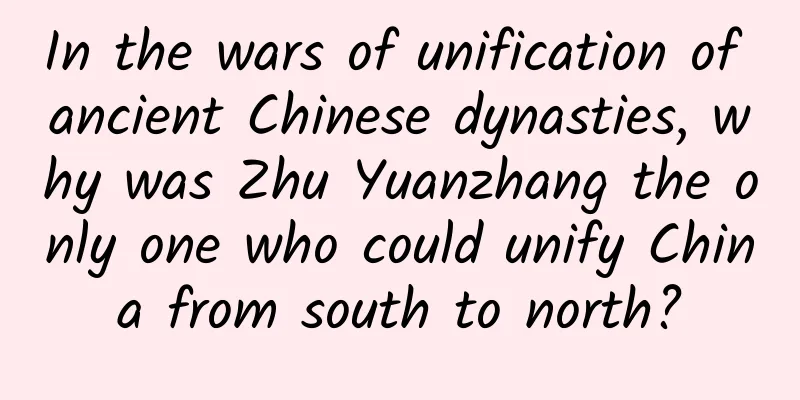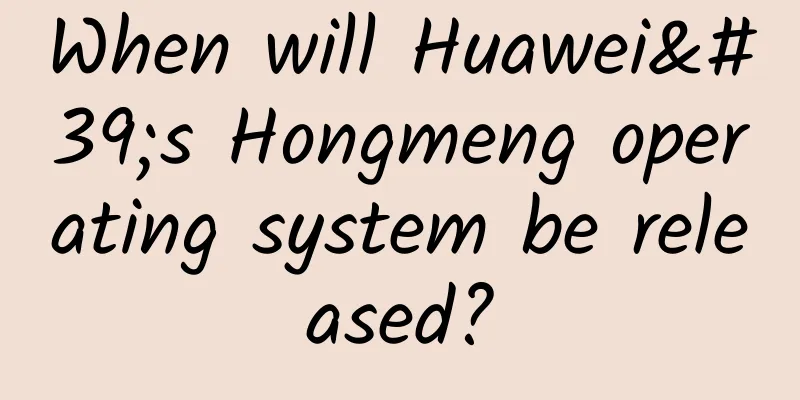In the wars of unification of ancient Chinese dynasties, why was Zhu Yuanzhang the only one who could unify China from south to north?

|
Although great unification was the mainstream and the trend of the times in ancient Chinese history, "the general trend of the world is that long-term unity will inevitably lead to division, and long-term division will inevitably lead to unity", so there have been many periods of great division and chaos. What is strange is that in most of the dynastic wars fought to end the great division and chaos, the regime or military group occupying the north won the final victory. For example, it was the Western Jin Dynasty that ended the Wei, Jin, Southern and Northern Dynasties, and it was the Northern Song Dynasty that ended the Five Dynasties and Ten Kingdoms (in fact, the Northern Song Dynasty was also partially unified). The only exception is Zhu Yuanzhang, who established his capital in Nanjing and achieved unification from south to north. In fact, in Chinese history, there are many people who almost achieved the feat of unifying the country from south to north, such as Huan Wen and Liu Yu of the Eastern Jin Dynasty, but they all failed to complete this feat. Why did this happen? There are probably the following reasons. First of all, the economic strength of the north is absolutely dominant. In ancient China, which was based on agriculture, agriculture was the economic lifeline and main source of taxation of a regime. Therefore, the more developed the agriculture of a country or regime is, the stronger its economic strength will be. Although the land in the south is vast and very suitable for farming. However, in the sparsely populated south, farming technology has long remained at the stage of "slash-and-burn farming". On the contrary, the farming technology in the north is far ahead of that in the south. Not only iron tools and curved plows are used extensively, but also many water conservancy projects are built. Developed agriculture can not only guarantee the country's taxes, but also allow the country to have a large population. Taking the Three Kingdoms as an example, the total population of Sun Wu (2,562,000 people) and Shu Han (1,082,000 people) in the south is not as large as that of Cao Wei (4,432,881 people). Because the north has developed agriculture, it can provide sufficient material and manpower guarantees during the wars of unification of dynasties. Although China's economic center of gravity has shifted southward after the Song Dynasty, the second advantage of the north began to emerge. That is the overwhelming military. In the cold weapon era, the military advantage is mainly reflected in the number of troops and the quality of the troops. Because the north has long had an economic advantage, it can quickly assemble and arm a large-scale army. For example, when the Sui Dynasty launched the war of unification, it was able to dispatch five armies with a force of about 500,000, which made the Southern Chen Dynasty unable to defend itself and could only accept the fate of destruction. At the same time, since the north has abundant pastures, it can form a large-scale cavalry corps. Although war horses are also raised in the south, the quantity and quality of war horses are far inferior to those in the north. Take the Yue Family Army of the Southern Song Dynasty as an example. By purchasing war horses from the north and captured in the war, a cavalry of about 8,000-10,000 people was formed. However, the number is far inferior to their opponent, the Jin Army. In the Battle of Yancheng alone, the Jin Army dispatched 15,000 elite cavalry including "Iron Pagoda" and "Crooked Horse". The south is already at a disadvantage in terms of the number of cavalry, and the gap in the quality of cavalry is even greater. Taking the Song Army as an example, the Song Army stipulated that the height of war horses should be between "four feet and one inch" and "four feet and seven inches" (about 127 cm to 146 cm), but in fact it could not be achieved at all, so many war horses of the Song Army were actually less than four feet and one inch tall. In contrast, the war horses in the north are basically around 140 cm. The height of a warhorse will directly determine the weight it can carry. Taking the Southern Song warhorse as an example, although the "large full-body" horse armor and "small full-body" horse armor have been invented, the weight of a cavalryman's armor is already between 20 kg and 25 kg. With weapons and equipment, it has reached about 50 kg. Therefore, the vests of the Song army's warhorses are mainly leather armor, such as "gold and silver red lacquer leather harness" and "steel red lacquer leather harness". However, among the opponents of the Song army, the Western Xia had "Iron Harriers" and the Jin Dynasty had "Iron Pagodas", all of which were covered with iron armor made by cold forging technology. While enhancing the protective ability, it also improved the impact capability of the heavy cavalry. Due to its advantages in both the number and quality of troops, the North has an absolute advantage in the unification wars of dynasties. However, if there is great turmoil in the north and a military genius emerges in the south, it will indeed make up for the gap between the two sides in terms of economy and military, and even achieve the final victory. For example, Zhu Yuanzhang's establishment of the Ming Dynasty is a very good example. However, often when the north is in chaos, the military geniuses in the south also face internal or their own problems. Take Liu Yu, the Emperor Wu of Song who later founded the Liu Song Dynasty, for example. In the Northern Expedition from the 12th year of Yixi (416 AD) to the 13th year of Yixi (417 AD), he almost recovered the entire area south of the Yellow River, as well as Guanzhong, which was known as the fertile land of 800 miles. Before Liu Yu, Huan Wen, a powerful official of the Eastern Jin Dynasty, also launched three Northern Expeditions, all of which achieved great results, and even recovered Luoyang, the former capital of the Western Jin Dynasty. Even more legendary is that Chen Qingzhi of the Southern Liang Dynasty, who only commanded 7,000 "white robe soldiers", swept across the Northern Wei Dynasty. However, after creating many military miracles, they failed to achieve the unification of the dynasty. The reason was "fire in the backyard". Just when Liu Yu was preparing to govern the north in order to consolidate the newly recovered land and continue to expand his military achievements, his confidant Liu Muzhi, who was in the capital, suddenly died. He wanted to replace the Sima family, but was worried that his foundation in Jiangnan would be shaken, so he had to return in a hurry. Huan Wen's purpose of the Northern Expedition was to establish his authority in the court of the Eastern Jin Dynasty in order to become the emperor in the future. Therefore, he did not dare to stay away from the court of the Eastern Jin Dynasty for a long time. Every time he went north, he would stop at a taste and return to the court quickly after achieving certain results. Although Chen Qingzhi had no ambition to usurp the throne, he had only 7,000 isolated troops. Without assistance and food supplies, he could only return home in defeat. From this we can see that in ancient China's dynastic unification wars, the reason why only Zhu Yuanzhang won the final victory from south to north was, in addition to economic and military reasons, the most crucial factor was the human factor. |
>>: This silly big dog has saved more than 4,000 people
Recommend
What are the techniques for attracting traffic to WeChat groups? How to use WeChat groups to attract traffic?
Nowadays, many companies have their own WeChat off...
90% of copywriters often make these three mistakes. Have you made any of them?
We always study how successful copywriting is wri...
There is only one last mile left! Is high-level autonomous driving really coming?
Recently, there has been a lot of good news in th...
Wanmen University - Python programming basics for beginners fun practical course
Baidu Netdisk download location: r-67-Wanmen Univ...
How to build a 2B user operation system!
Taking Ouyeel Cloud Commerce’s B2B growth practic...
Do your genes determine your life choices?
© The New York Times Leviathan Press: In recent y...
Luo Yonghao's Craftsman Rhapsody: A Mobile Phone War Aiming at "Feelings"
A mobile phone war targeting "sentiment"...
Tencent Advertising Marketing Optimization Strategy
Please explain in detail what kind of promotional...
HTC launches blockchain phone, is it the last attempt to subvert Or?
HTC has launched a new mobile phone! However, as ...
If you don't do it, you won't die. Gome staged a farce of using its own weaknesses to fight against others' strengths.
On August 12, at the "Third China Home Appli...
Experience summary | Building a user incentive system for your own APP from scratch
Recently, the company’s new product has begun pla...
AMD's new flagship A12-9800 review: finally using DDR4 memory
Intel has started pre-selling the seventh-generat...
Meizu 16Xs review: light and thin, long battery life + wide-angle triple camera, defending the last dignity of the thousand-yuan phone market
This year can be said to be the year of close com...
An investor's view of "Xiachufang": the story before the $30 million financing
Editor's note: [Xiachufang], this APP is not ...
From a monthly salary of 3,000 to 30,000, 10 tools to improve operational efficiency
The era of operation being king has arrived. As a...









